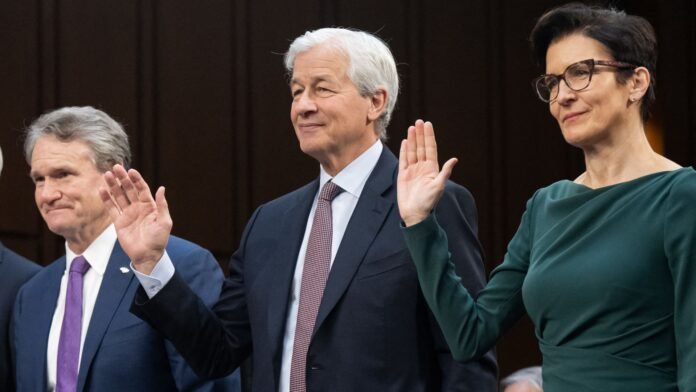Contents
US Banks Post Record Profits Amid Economic Resilience and Financial Market Boom
The six biggest US banks have posted a combined profit of approximately $39 billion in the second quarter, exceeding analysts’ expectations and jumping over 20% from core earnings a year ago, as the American economy continues to defy expectations of a downturn despite a tumultuous start to the quarter.
The resilience of the US economy and a boom in financial markets have resulted in a highly profitable environment for financial firms. As of July 2025, Wall Street is experiencing a significant surge in stock and bond trading, with corporations engaging in massive loans and acquisitions. Main Street is also holding up, with the American consumer continuing to spend, borrow, and repay loans, according to reports from the largest US banks. The unexpected profitability is largely attributed to the recovery from the initial shock of President Donald Trump’s sweeping “Liberation Day” tariffs, which had initially caused market turmoil.
Corporate Confidence and Investment Banking
JPMorgan Chase, the largest and most profitable US bank, has produced $15 billion in quarterly profit, nearly as much as the next three largest banks combined. The bank’s trading revenue benefited from turbulent market conditions, while investment banking revenue jumped 7%, driven by mergers advice, IPOs, and debt and equity issuance. JPMorgan CFO Jeremy Barnum stated that the pickup in investment banking fees reflects people’s acceptance of uncertainty and decision to move forward with transactions. The corporate community has learned to navigate through the challenges, and as a result, investment banking fees have increased.
Key Highlights
* The six biggest US banks generated approximately $39 billion in second-quarter profit, exceeding analysts’ expectations and jumping over 20% from core earnings a year ago.
* JPMorgan Chase produced $15 billion in quarterly profit, driven by trading and investment banking revenue.
* Investment banking revenue at JPMorgan jumped 7%, with managers initially warning of a 15% decline.
* Corporate confidence has increased, with companies deciding to move forward with transactions despite uncertainty.
Soft Landing and Economic Risks
JPMorgan’s internal barometers for US economic risks have cooled down, reducing the likelihood of a recession causing a spike in US unemployment. The bank’s provision for credit losses was 14% smaller than in the first quarter, indicating a decrease in economic risks. The economy is currently in a “soft landing” scenario, with consumers and companies borrowing more money from JPMorgan, driven by rising credit card and wholesale loans. The US economy has defied expectations of a downturn, and banks are giving the all-clear signal on the economy.
Supporting Factors
* The Federal Reserve’s proposal to amend the capital that banks need to hold for lower-risk assets could free up billions of dollars for banks.
* Trump’s spending bill preserves corporate tax rates and expands business deductions, which could boost the economy.
* Deregulatory efforts across industries could also contribute to economic growth.
Firing on All Cylinders
The current setup is ideal for banks, with rates at a good level, deal activity high, capital markets strong, and consumer credit excellent. JPMorgan CEO Jamie Dimon sounded relatively optimistic about the economy, stating that it’s been resilient and hopes it will continue to be. The world is more diversified, making for a slightly more stable global economy. Even the banking industry’s former laggards, such as Wells Fargo and Citigroup, are showing signs of a resurgence, with their shares climbing nearly 30% this year.
Quotes from Industry Leaders
* “Look how far the world’s come in three months.” – Mike Mayo, Wells Fargo banking analyst
* “It’s been resilient, and hopefully it’ll continue to be.” – Jamie Dimon, JPMorgan CEO
* “The strength of the US economy, driven by the American entrepreneur and a healthy consumer, has certainly been exceeding expectations.” – Jane Fraser, Citigroup CEO
Good Times Ahead?
The future looks promising for the banking industry, with the economy defying expectations of a downturn and financial markets booming. The Federal Reserve’s proposal to amend capital requirements could free up billions of dollars for banks, and deregulatory efforts could contribute to economic growth. The CEO of Citigroup, Jane Fraser, has convinced investors that her turnaround plan is working, and the bank’s shares have climbed nearly 30% this year.
Conclusion:
The US banking industry is experiencing a highly profitable environment, driven by the resilience of the US economy and a boom in financial markets. Despite initial concerns about the impact of President Trump’s tariffs, the economy has defied expectations of a downturn, and banks are giving the all-clear signal on the economy. The future looks promising, with the Federal Reserve’s proposal to amend capital requirements and deregulatory efforts potentially contributing to economic growth.
Keywords:
US banking industry, financial markets, economic resilience, corporate confidence, investment banking, soft landing, economic risks, Federal Reserve, deregulation, Trump tariffs, JPMorgan Chase, Wells Fargo, Citigroup, Jamie Dimon, Jane Fraser, Mike Mayo.
Hashtags:
#USBankingIndustry #FinancialMarkets #EconomicResilience #CorporateConfidence #InvestmentBanking #SoftLanding #EconomicRisks #FederalReserve #Deregulation #TrumpTariffs #JPMorganChase #WellsFargo #Citigroup #JamieDimon #JaneFraser #MikeMayo
Source link
